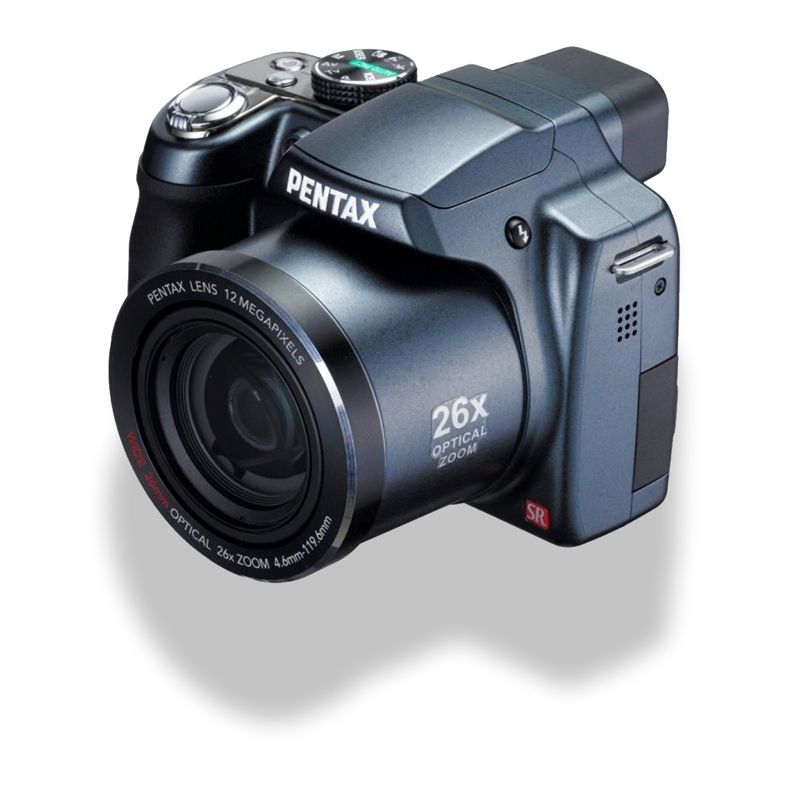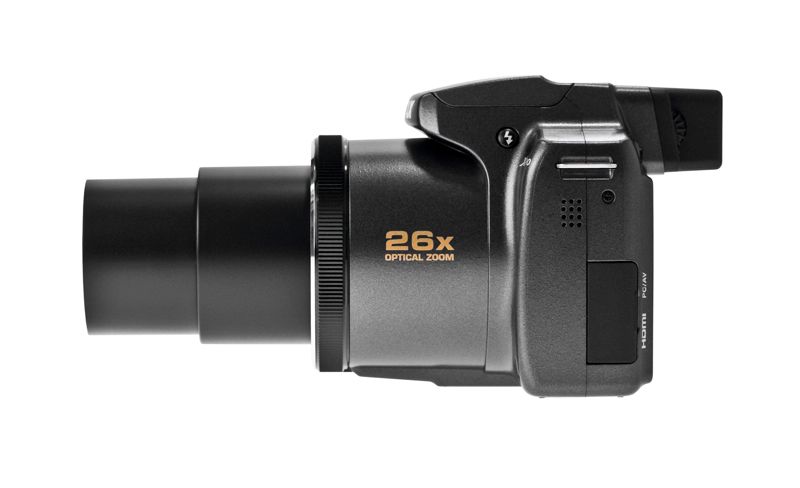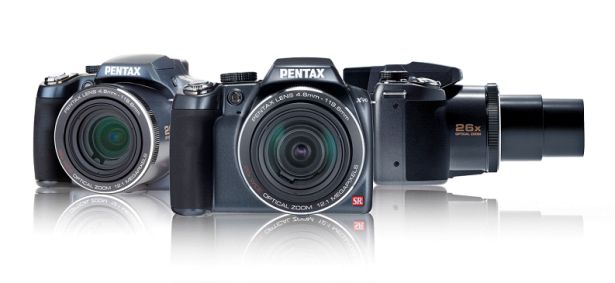Having a larger than average zoom always comes in useful, but the bulk that often comes with it means it's not always practical, or portable. One solution is Pentax's X90. Clearly with a look and feel inspired by a digital SLR, the camera welds a non-swappable 26x optical zoom to a sensor producing 12 effective megapixel still images and 1280 x 720 pixels high-definition video at 30 frames per second, with continuous shooting of up to 11fps.
Our quick take
The Pentax X90 is all about shoehorning as broad a focal range as possible into a DSLR-like chassis, and as such it largely succeeds as a catch all device, being as adept at shooting expansive landscapes as intimate portraits and everything else in between. The trade off is that it is more plastic-y of build than an actual DSLR and of course by being an all-in-one there's no access to a broad DSLR system accessory range.
We were disappointed that the lens stays put when shooting video and that its low light performance could be better, but in all other regards the X90 is a capable contender - probably best suited to the family user who doesn't specialise in one particular type of photo or subject, so will admire the Pentax's flexibility and portability.

Pentax X90 camera - 4.0 / 5
| FOR | AGAINST |
|---|---|
|
|
In doing so this gunmetal grey "bridge" model offers a step on from its 24x zoom X70 predecessor. It's also a much cheaper and more portable alternative to a DSLR proper, equipped with an equivalent paparazzi-like focal range, which here is a wide angle 26-676mm in 35mm film terms. That said, the X90 does cost £330, if taking its manufacturer's suggested price as gospel, which is indeed as much as an entry-level DSLR body.
So why is the X90 a viable alternative? Well apart from that massive zoom, within manageable proportions of 84.5 x 111 x 110mm and weight of 428g with rechargeable lithium ion battery and SD/SDHC/Eye-Fi media card loaded, its manufacturer claims that it does everything you could want, except the ironing.
Quick to power up in just over a second, by way of partial justification, Pentax has included what it has christened an "Intelligent Zoom" function. This runs on from the end of the optical range if you keep your forefinger on the zoom lever encircling the shutter release button and, with incremental resolution drops, boosts telephoto performance to either a 33.9x equivalent at 7 megapixels or mind-blowing 162.5x if you don't mind shooting at a fuzzy 640 x 480 pixels resolution. The degraded image quality is due to the camera effectively performing a digital crop.
At the other end of the zoom scale, close up/macro shooting is possible at a distance down to 1cm from your subject, which is as good as you could hope for. Otherwise in operation the zoom is rapid in its response, the camera racing through its entire optical range in all of 3 seconds. On the other hand this means that it's tricky to precisely pinpoint your framing, but it is possible to tab forward and back in baby steps.
The X90's top plate mode dial offers a full complement of real photographic shooting modes - program, aperture priority, shutter priority plus manual - alongside the fully automatic likes of Auto Picture mode, which "recognises" common scenes and subjects thanks to eight on-board presets and adjusts its shooting parameters accordingly. Mostly reliable, if confused momentarily by busy scenes, this enables users to point and shoot to begin with and progress to making personal tweaks as experience grows.
On the same shooting dial is also where we find the movies setting, in the absence of a dedicated one-touch record button, a la Panasonic. Filming instead commences and ends with press and subsequent press of the shutter release button. With HD features and digital TV increasingly important, HDMI output is offered alongside regular AV and USB connectivity, ports protected by a side flap.
Disappointment though comes due to the fact that the optical zoom cannot be accessed once movie recording has commenced; the lens stays fixed at the point it was at before the shutter release button was pressed. This is usually because the mechanism used to power the zoom is noisy, but in our humble opinion the Pentax didn't sound that bad.
Picture or movie composition is either via 2.7-inch standard 230k-dot resolution back plate LCD - we'd expected higher - or 200k-dot electronic viewfinder (EVF) directly above. The eye relief for the latter juts out quite prominently from the body; on the one hand this commendably prevents your nose squashing up against the LCD below when using the EVF, but makes it tricky to use as a viewer if wearing glasses as your frames clunk up against it.
The camera feels quite plastic-y when gripped, and we can see the slip-on lens cap easily getting lost, but thankfully the side grip is sufficiently large to be able to wrap three fingers around it and help steady the device if shooting handheld at longer telephoto settings. This is backed up by sensor shift type anti-shake providing, says Pentax, the equivalent of three stops, gyro sensors detecting external wobble and triggering compensatory adjustments to minimise blur. Digital shake reduction is also accessible with a twist of the mode dial, boosting ISO to compensate, but with a compensatory resolution drop to 5 megapixels.
Though its smaller form factor means its button and control layout looks busy, start using the camera and it transpires that these are well placed, as well as being clearly marked with variously icons and text. The result is that fingers and thumbs quickly find controls and camera operation quickly becomes intuitive.
Providing a place to rest the left hand when taking photographs hand held and steady it further, there's also what looks like a manual focus ring encircling the lens barrel, but this ridged edging transpires to be purely a design quirk. Flash is of the pop-up variety, and there is an attendant red eye reduction setting to further help avoid devil's eyes, but no hot shoe for supplementary flash. The camera has to be switched on before the dedicated side button will raise the flash; and this has to be performed manually when it is, an on-screen text prompt asking you to do so if you attempt to swap modes with it still closed. Competing big zoom models, such as Kodak's slightly more unwieldy Z981 or Canon's even more compact PowerShot SX210 IS, pop the flash up automatically.
In operation the X90's 9-point AF takes just over a second to determine focus and exposure with a half press of its shutter release button. There are three JPEG quality levels offered by the X90, but no RAW option, which could be viewed as an oversight by some. Still, committing a maximum resolution picture to memory takes just 2 seconds. Like its zoom range, ISO sensitivity is also respectably broad, stretching from ISO 80 through to ISO 6400, though performance is in fact fairly average. Images are quite noisy at ISO 1600 and resemble watercolours at ISO 6400 as in-camera processing softens detail to disguise the appearance of grain.
In terms of a "fun" element the X90 pulls in some tricks from its DSLR range and offers some digital effects filters. These most notably include the Lomo-like Toy Camera plus Retro options - but here applied in playback mode rather than at the point the photo is captured; non-essential perhaps, but providing a point of difference none the less.
To recap
The Pentax X90 is probably best viewed as an all-in-one option for someone who wants a step up from a 3x zoom compact, but prefers the portability and usability of a bridge model rather than fully blown DSLR which will require additional and expensive lenses to match the expansive range offered here




